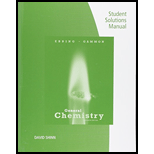
(a)
Interpretation:
A solution is made of volatile solute and another solution is made of non-volatile solute. Of the two solutions the solution having higher vapor pressure and higher boiling point has to be identified.
Concept Introduction:
Vapor pressure of a substance is known as the pressure exerted by molecules on the vapor phase when they are in equilibrium with their actual phase which can be liquid or solid.
A substance is said to be volatile if it vaporizes readily at room temperature itself. Such substances have high vapor pressure as most of its molecules tend to exist in vapor phase. A substance is said to be non-volatile if it doesn’t vaporize spontaneously and remains stable.
Vapor pressure of a volatile solvent can be lowered by addition of a non-volatile solute. Raoult’s law deals with the vapor pressure of pure solvents and solution which states –
Partial pressure of solvent is equivalent to the product of vapor pressure of the solvent in its pure state and mole fraction of solvent in the solution. It is expressed as,
Where,
When the solute is non-volatile, the vapor pressure of the whole solution is equal to
The lowering of vapor pressure of the solvent due to the addition of non-volatile solute is expressed as,
Where,
Boiling point of a liquid substance is defined as the temperature at which the vapor pressure of the liquid becomes equal to the atmospheric pressure.
(b)
Interpretation:
A solution is made of volatile solute and another solution is made of non-volatile solute. Of the two solutions the solution having higher vapor pressure and higher boiling point has to be identified.
Concept Introduction:
Vapor pressure of a substance is known as the pressure exerted by molecules on the vapor phase when they are in equilibrium with their actual phase which can be liquid or solid.
A substance is said to be volatile if it vaporizes readily at room temperature itself. Such substances have high vapor pressure as most of its molecules tend to exist in vapor phase. A substance is said to be non-volatile if it doesn’t vaporize spontaneously and remains stable.
Vapor pressure of a volatile solvent can be lowered by addition of a non-volatile solute. Raoult’s law deals with the vapor pressure of pure solvents and solution which states –
Partial pressure of solvent is equivalent to the product of vapor pressure of the solvent in its pure state and mole fraction of solvent in the solution. It is expressed as,
Where,
When the solute is non-volatile, the vapor pressure of the whole solution is equal to
The lowering of vapor pressure of the solvent due to the addition of non-volatile solute is expressed as,
Where,
Boiling point of a liquid substance is defined as the temperature at which the vapor pressure of the liquid becomes equal to the atmospheric pressure.
Trending nowThis is a popular solution!

Chapter 12 Solutions
Student Solutions Manual for Ebbing/Gammon's General Chemistry, 11th
- For the condensation reaction between Alamine and histamine, please help me write the amididation reaction mechanism. Then write the three letter code for the product of the reaction, then write the one letter code for the product of the reaction. arrow_forwardHow to draw the reaction mechasnism belowarrow_forwardName the following molecules with IUpacarrow_forward
- What is the molecular orbital for cyclopropenyl anion and is it aromatic, antiaromatic or nonaromatic?arrow_forwardUsing the chart describe the change from cystine to tyrosine and its impact on the protein. Using the chart describe the change from histidine to aspartic acid and its impact on the protein.arrow_forwardHow to get the predicted product of this reaction belowarrow_forward
- Please help me fill out the chart then using the chart describe the change from cystine to tyrosine and its impact on the protein. Then using the chart describe the change from histidine to aspartic acid.arrow_forwardWrite the Esterification reaction mechanism for acetic acid, and one propanol to make propanol ethanoate (molecule that gives peas its odor in flavor)arrow_forwardProvide solutionsarrow_forward
 Chemistry: Principles and PracticeChemistryISBN:9780534420123Author:Daniel L. Reger, Scott R. Goode, David W. Ball, Edward MercerPublisher:Cengage Learning
Chemistry: Principles and PracticeChemistryISBN:9780534420123Author:Daniel L. Reger, Scott R. Goode, David W. Ball, Edward MercerPublisher:Cengage Learning Principles of Modern ChemistryChemistryISBN:9781305079113Author:David W. Oxtoby, H. Pat Gillis, Laurie J. ButlerPublisher:Cengage LearningChemistry: Matter and ChangeChemistryISBN:9780078746376Author:Dinah Zike, Laurel Dingrando, Nicholas Hainen, Cheryl WistromPublisher:Glencoe/McGraw-Hill School Pub Co
Principles of Modern ChemistryChemistryISBN:9781305079113Author:David W. Oxtoby, H. Pat Gillis, Laurie J. ButlerPublisher:Cengage LearningChemistry: Matter and ChangeChemistryISBN:9780078746376Author:Dinah Zike, Laurel Dingrando, Nicholas Hainen, Cheryl WistromPublisher:Glencoe/McGraw-Hill School Pub Co Chemistry: The Molecular ScienceChemistryISBN:9781285199047Author:John W. Moore, Conrad L. StanitskiPublisher:Cengage Learning
Chemistry: The Molecular ScienceChemistryISBN:9781285199047Author:John W. Moore, Conrad L. StanitskiPublisher:Cengage Learning Introductory Chemistry: An Active Learning Approa...ChemistryISBN:9781305079250Author:Mark S. Cracolice, Ed PetersPublisher:Cengage Learning
Introductory Chemistry: An Active Learning Approa...ChemistryISBN:9781305079250Author:Mark S. Cracolice, Ed PetersPublisher:Cengage Learning World of Chemistry, 3rd editionChemistryISBN:9781133109655Author:Steven S. Zumdahl, Susan L. Zumdahl, Donald J. DeCostePublisher:Brooks / Cole / Cengage Learning
World of Chemistry, 3rd editionChemistryISBN:9781133109655Author:Steven S. Zumdahl, Susan L. Zumdahl, Donald J. DeCostePublisher:Brooks / Cole / Cengage Learning





